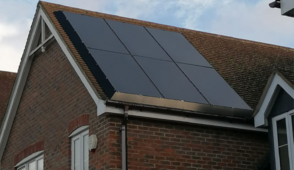One interesting side effect of mounting solar panels on the roof has been looking at attic temperatures.
Measuring the underside of the deck it seems like there's a pretty clear difference between underneath the panels, and roof that's exposed to the sun.
Just measuring right now (outside temperature 64degF, sunny, 2:30PM).
Underneath the panels, I'm seeing (depending on how you squint) ~83degF. Under exposed roof, I'm seeing ~98degF. That's a +15degF delta!
Assuming I remember my thermo equations correctly:
ΔTC=95×(83°F−80°F)=95×3°F=1.67°C (with panels)
ΔTC=95×(98°F−80°F)=95×18°F=10°C (without panels)
Q=(k⋅A⋅ΔT)/d
where 𝑘=0.15k=0.15 W/m·K, 𝐴=1A=1 m², Δ𝑇𝐶=1.67 or 10°C, and 𝑑=0.01905.
Q=(0.15W/m×K×1m2×10°C)/0.019m = ~79 W/sq m of roof (without panels)
and for ΔTC = 1.67°C --> ~13 W/sq m of roof (without panels)
That's a difference of 79W - 13W = 66W / sq meter.
For my 30 panels (.990m * 1.67m) * 30 = ~50 sq meters.
50 sq meters * 66W = 3.3kW of extra heat without panels in place -- that's like having two space heaters running in the attic!
What this means in terms of actual house temperatures is a bit unclear, but I'm sure it's probably measurable.
Has anyone measured attic temperature and house temperatures before / after installing solar panels and seen any difference? Very curious to see a year's worth of data.
Measuring the underside of the deck it seems like there's a pretty clear difference between underneath the panels, and roof that's exposed to the sun.
Just measuring right now (outside temperature 64degF, sunny, 2:30PM).
Underneath the panels, I'm seeing (depending on how you squint) ~83degF. Under exposed roof, I'm seeing ~98degF. That's a +15degF delta!
Assuming I remember my thermo equations correctly:
- Thermal Conductivity (k): 0.15 W/m·K (wood)
- Thickness of the roof deck (d): 3/4 inch = 0.019 meters
- Area (A): heat flow per square meter for simplicity.
ΔTC=95×(83°F−80°F)=95×3°F=1.67°C (with panels)
ΔTC=95×(98°F−80°F)=95×18°F=10°C (without panels)
Q=(k⋅A⋅ΔT)/d
where 𝑘=0.15k=0.15 W/m·K, 𝐴=1A=1 m², Δ𝑇𝐶=1.67 or 10°C, and 𝑑=0.01905.
Q=(0.15W/m×K×1m2×10°C)/0.019m = ~79 W/sq m of roof (without panels)
and for ΔTC = 1.67°C --> ~13 W/sq m of roof (without panels)
That's a difference of 79W - 13W = 66W / sq meter.
For my 30 panels (.990m * 1.67m) * 30 = ~50 sq meters.
50 sq meters * 66W = 3.3kW of extra heat without panels in place -- that's like having two space heaters running in the attic!
What this means in terms of actual house temperatures is a bit unclear, but I'm sure it's probably measurable.
Has anyone measured attic temperature and house temperatures before / after installing solar panels and seen any difference? Very curious to see a year's worth of data.



